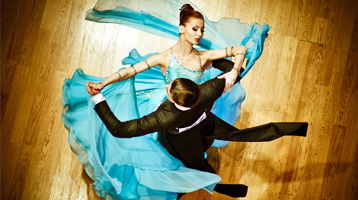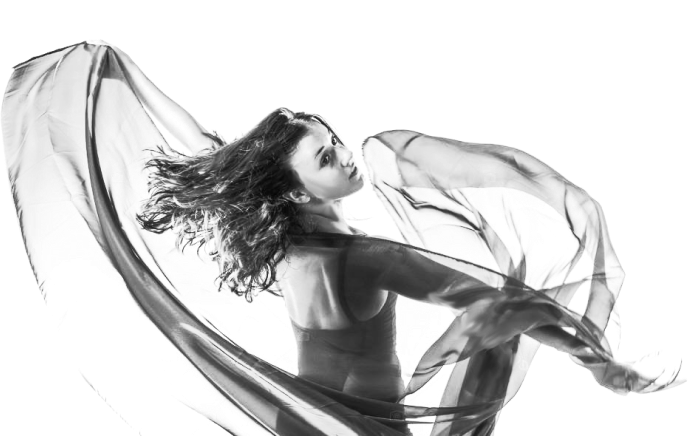
Ballroom Dancing
Viennese Waltz
The Viennese Waltz is a classic dance style that is featured in many romantic movies and animated films. It is characterized by sweeping, graceful turns that rotate quickly around the floor. Although it shares many similarities to the slow Waltz, it is danced at a much faster tempo—twice the speed of the slow Waltz.
History of the Viennese Waltz
The Viennese Waltz is the oldest form of ballroom dance. It emerged in the 18th century around 1750. Its precursors originate back to the 12th century to a dance of the Middle Ages known as the Round. The final turn of the dancing couple in the Round was the highlight of the dance, and this complete turn became characteristic of the Viennese Waltz. The ¾ time that makes Viennese waltz possible dates back at least as far as 1679 when “Das Lied vom lieben Augustin” was written.
Viennese Waltz developed more directly from the Landler, the Deutscher, the Dreher and the Schleifer. These were local folk dances in Bavaria and Austria in the 18th century. When those living in the cities adopted these dances, their character changed immensely. They changed both musically as well as in the choreography. The tempo of the dance became much faster, and graceful gliding replaced the popular hopping movement of the folk dances. The dance moved from the country dance halls to the ballrooms of high society and the Viennese Waltz was born. At the time, it was only known as “waltz”, but the later introduction of the slower waltz was the reason why the faster original version was renamed and differentiated by as “Viennese Waltz” after its place of origin.
The Viennese Waltz arrived to England after the war of 1812. In 1814, the Viennese Waltz was said to assist putting the ambassadors to the Congress of Vienna in the frame of mind to amicably settle the chaos left after Napoleon’s first retirement. The Viennese Waltz has held a strong history in Vienna where there are still about 300 public dance balls held within the first three months of the year. Some balls have an attendance of up to 5000 dancers in this city of only 1.5 million.
Prior to the birth of Viennese Waltz, the aristocrats cultivated slow dances at their courts with very rigid and strictly bound ceremonies that did not permit any liberties. Dancing partners had to keep their distance with just a slight touch of the hands. The Viennese Waltz required the man to places his hands on the woman’s hips. Pairs danced in very close holds and looked at each other rather deeply in the eyes. The Viennese Waltz offered a more liberal lifestyle compared to the rigid manners of aristocratic dances. Viennese Waltz allowed dancers to drop their composure and free their emotions. Initially, these liberties presented by Viennese Waltz were considered very scandalous. Women’s ankles were exposed as they danced around the floor and couples embraced too closely for social approval. This is why the dance was even banned for some time. Eventually the Viennese Waltz took the ballrooms by storm and gained so much popularity that even the high societies also accepted the dance with enthusiasm. The dance was finally able to slowly, but surely, gain acceptance into the courts.
The style of Viennese Waltz was shaped in Habsburgian, Vienna. It was there that the movement evolved and classical musicians took up the Waltz rhythm. The music of composers Johann Strauss and Joseph Lanner helped to popularize the faster Viennese Waltz. In the 19thcentury, many variants of the Viennese Waltz emerged including the Polish Mazurka Waltz, the Hungarian Waltz, the Mexican Waltz, The French Waltz and the Musette Waltz. The Viennese Waltz continued to gain popularity throughout the 20th century and into the 21stcentury. Viennese Waltz is now recognized as a ballroom dance staple around the world.
Viennese Waltz Dancing Today
Today, Viennese Waltz is danced at the competitive level in both the International Standard and American Smooth Ballroom categories and is still a popular social dance in ballroom dance studios.
International Style Viennese Waltz is danced in a closed position and the syllabus is limited to certain movements including natural and reverse turns, changes, fleckerls, contra check, left whisk, and canter pivots. American Style Viennese Waltz is danced in both open and closed dance positions and has much more freedom than it’s International counterpart. It’s full of fun interpretations with a more theatrical feel leaving closed position to explore alternative holds, underarm turns and side by side choreography.
Viennese Waltz events, balls, and competitions are held throughout the world annually. Some of these events feature purely Viennese Waltz dancing while others include other styles of ballroom dance. In the United States, the Viennese Waltz has been brought to America’s pop culture forefront via famous TV shows such as “So You Think You Can Dance” and “Dancing with the Stars.” The grace, flow, and beauty displayed by Viennese Waltz dancers draw a mass appeal to any admiring spectators. It is a popularly requested dance at ballroom dance studios around the world.
Viennese Waltz Music
- “The Potter Waltz” Prague Philharmonic Orch.
- “I Know You” Sleeping Beauty
- “You and Me” Lifehouse
- “Sofia” Johann Strauss
- “Only Hope” Mandy Moore
- “FanFan” 101 Strings Orchestra
- “I’m With You” Avril Lavigne
- “Skin” Rascal Flatts
- “That’s Amore” Dean Martin
- “Kiss from a Rose” Seal
- “Fallin’” Alicia Keyes
- “Break Away” Kelly Clarkson
- “One and Only” Adele
- “All I Need” Within Temptation
- “Breathe (2am)” Anna Nalick
- “The Time of Your Life” David Cook
- “Carribean Blue” Enya
- “A New Day Has Come” Celine Dion
- “A Thousand Years” Christina Perri
- “Always and Forever” Luther Vandross
- “Delilah” Tom Jones
- “Enamorada” Sandra Cartolari and Claudio Novelli Orchestra
- “Iris” The Goo Goo Dolls
- “These Arms of Mine” Otis Redding
- “Cryin” Aerosmith
- “This Love” Leanne Rimes
- “Beautiful Life” Lindsay Lohan
- “I Have Nothing” Whitney Houston
- “You’re My Number One” Enrique Iglesias
- “Your Guardian Angel” The Red Jumpsuit Apparatus
- “End of the Road” Boys 2 Men
- “Ill Make Love to You” Boys 2 Men
- “Runaway” The Corrs
- “Amas Veritas” Alan Silvestri
- “That’s Amore” Dean Martin
- “Que Sera Sera” Doris Day
- “Walkin’ Away” Clint Black
- “Tu Solo Tu” Selena
- “I Won’t Give Up” Jason Mraz


